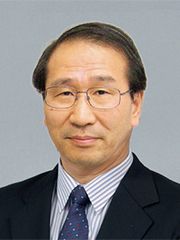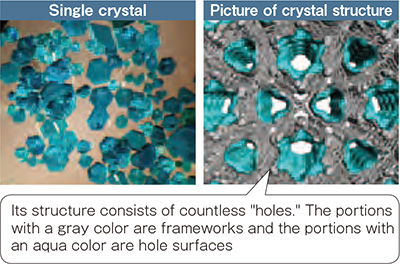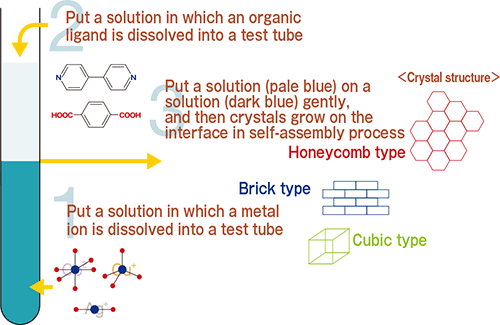Research Results
Selective gas adsorption and separation
Development of porous coordination polymers (PCP) FY2016

- Susumu Kitagawa (Director/Professor, Institute for Integrated Cell-Material Sciences (iCeMS), Kyoto University)
- ERATO
- "KITAGAWA Integrated Pores Project" Research Director (2007-2014)
- ACT-C
- "Methanol Synthesis in Porous Coordination Polymers as Reaction Field" Principal Investigator (2012-2017)
- ACCEL
- "The Nanospace Science of PCP for Molecular Control" Research Director (2013-2018)
Collection of carbon dioxide generated from fossil fuel becomes possible
Gases, such as oxygen, carbon dioxide, methane, hydrogen, etc., are harder to deal with than solid substances and aqueous fluids. It is expected that the development of technology that separates and stores gases selectively can lead to the breakthrough in various fields. If carbon dioxide emitted from factories etc. can be captured and stored, it will greatly contribute in solving environmental problems. If hydrogen can be easily generated from water, dissemination of fuel battery would no doubt advance rapidly. The development of porous coordination polymers (PCP) by Professor Susumu Kitagawa has the potential to open the gate for such an innovation.
Porous coordination polymers (PCP)

Adsorption of gases with small molecule size
- flexible designability to create various functions-
Previously, zeolite, which has a porous structure with countless "holes," was widely used as an adsorbent for gases. Since the surface area is large, it can adsorb a large amount of gas molecules. Carbon (activated carbon), which has been used as an air refresher since long before, also has this "porous" structure and adsorbs gas molecules in air which are the source of smelling. These materials are called "porous materials," and they have led to research on the adsorption of target molecules by changing their pore size.
Professor Kitagawa made a breakthrough in this situation even though he was not a researcher of porous materials. He majored in "coordination chemistry." Metal complex has the structure of bonding organic molecules (ligands) around a metal ion. It can obtain various functions by changing the kind of metal ions and ligands. Thus, it has great potentiality as a new porous material.
However, metal complexes including organic molecules are unstable in their structures, and they are extremely easy to break down. Professor Kitagawa was the first to demonstrate that a porous metal complex can adsorbs gases reversibly without collapse of the porous structure. Furthermore, he achieved the production of a metal complex that changes its structure or its property in response to surrounding environments and external stimuli, which enables adsorption and desorption with high selectivity. The new material, which is named Porous Coordination Polymer (PCP), has been researched and developed for practical use across the world as an epoch-making adsorbent that surpasses the previous limitation of conventional porous materials.
Synthesis of PCP

Looking into the structures and phenomena without making haste for actual use
Professor Kitagawa started ERATO "KITAGAWA Integrated Pores Project" in 2007, and focused on bringing out new knowledge by looking into the PCP structure and property, rather than advancing technological development that led to immediate practical realization.
He has investigated the unique property of the micropore in a PCP showing structural transformations to effectively accommodate target molecules and succeeded in controlling the strength of taking in molecules by downsizing the PCP particle size to the utmost limit. Furthermore, he paid attention to the difference in electronic properties between oxygen and nitrogen that are difficult to be separated due to the resemblance in size and shape. He then synthesized a PCP that shows a partial electron transfer between host and guest, and easily separated oxygen from the air that consists of 78% nitrogen and only 20% oxygen. He was also successful in selective adsorption oxygen, carbon monoxide, etc. by transformation of PCPs in response to the condition of pressure, light, and temperature. In addition, he is developing a PCP that discriminate super subtle difference in the structures of molecules that are taken in, and provides information with emission color.
These research achievements largely extend the potentials for practical use of PCPs, such as enhancing the selectivity of the adsorption and separation of targeted molecules, providing application for sensors, etc.
Capturing oxygen by activating PCP with irradiation

The time has come for practical realization based on the obtained knowledge
In 2013, ACCEL Research and Development Subject of "The Nanospace Science of PCP for Molecular Control" started. The aims of this research project are to further enhance separation performance, to elucidate its mechanism, and to develop its production method pertaining to the PCP of carbon monoxide adsorption that provides the highest performance of gas separation among PCPs, while advancing research. At the same time, it is also expected development of a potential use of PCP in the wide field of gas related applications such as gas separation, purification and conversion.
Although he did not majored in porous materials, Professor Kitagawa discovered the great potentials as porous materials based on his own research background in coordination chemistry, developed the new materials called PCP, sought for a new science in PCPs, and expanded the possibilities for practical use. He is attracting attention as a major candidate for the Nobel Prize in Chemistry.
